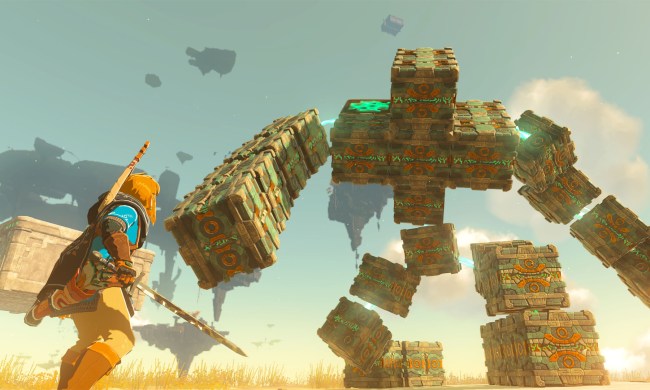Creating an open-world exploration game, set in a colorful land of adventure, will inevitably invite comparison to The Legend of Zelda: Breath of the Wild. Casting Patricia Summersett, the English voice actor of Zelda herself, as the lead serves as proof that Elements doesn’t just hear these comparisons, it embraces them. Developer Wreckit Games is taking a bold risk tying itself to one of the greatest games of all time, but if it can pull off its ambitious plans, this could be the game that needs to be on everyone’s radar.
Paying homage to the legend

I sat down with Devon Parson, the solo developer behind Elements, in the Apogee Media suite at PAX West, and he told me about his dream game. He envisioned an open-world adventure game he could play with his kids — one that drew elements from other great franchises like Zelda and The Elder Scrolls.
With this in mind, I began my hands-on demo. I played as Nyah (Patricia Summersett’s character), a young girl transported to Elemythia, a magical land linked to our own world. Directionless, I found myself in the middle of a lush forest. I did what any good adventurer does. I picked a point that looked interesting, in this case a village by a lake, and wandered off to see what I could find.
I didn’t have to go far before I encountered my first monster, a human-sized, anthropomorphic mushroom creature who was not happy to see me. The combat was straightforward, and played somewhat similarly to The Witcher, with a mix of strikes, blocks, and dodges. I had an ax in my right hand, a shield in my left, each mapped to the corresponding trigger on my gamepad. A few quick swings of my ax and the creature fell, leaving behind Elemental Essence, a currency used for upgrades. Elmythia, I was told, is divided into eight elemental biomes, with unique enemies, and each will drop Essence corresponding to their region.
I dispatched a few more mushroom creatures using a bow and arrow, as I made my way toward the village. It was a small town with a few houses and shops. I came to an anvil near the town square, where I was able to convert some materials I had into an upgraded ax. Weapons can be found by defeating powerful enemies or built from scratch. There is no degradation system like in Breath of the Wild. Instead, weapons come in tiers. Epic is stronger than rare, legendary is stronger than epic, etc. It is possible to craft weapons and armor comparable to high-level monster drops, but doing so requires special blueprints, and time invested to gather materials.
Make yourself at home

This sleepy village next to the lake seemed like a great place to settle down, so I went to work building a house. Building structures uses a simple grid-based system. You select the part of a house, like a floor or a wall piece, and place pieces together. I quickly fabricated a small, single-room abode for myself. These homesteads can only be built in villages, and require you to earn the trust of the villagers by completing side quests before you will be allowed to build there. Once you have them, they are invaluable, acting as fast travel points, crafting areas, and shared storage for your belongings.
The world of Elements is colorful and vibrant. Nature stretches in each direction and promises to be filled with secrets to uncover. I jumped into the lake near the village and swam to the bottom to find some ruins hiding a treasure chest. The terrain is varied. Certain assets, Devon told me, are procedurally generated, allowing them to all look original, without filling the developers’ time with handcrafting each one. Apparently, it worked. I ran through quite a lot of greenery, and it all seemed to fit together without the uncanny feeling of everything being the same.
I emerged from the other side of the lake and journeyed forward into the forest. Eventually, the trees began to clear, and the foliage transitioned from dense evergreen to more of a rain forest setting, an example of how each of the eight elemental biomes contains sub-regions, each with its own look and character. As you approach the core of a region, enemies scale-up, becoming more dangerous as you near the elements controlling each biome.
An ambitious wish list

I spent the last few minutes of my time exploring. I found an old stone bridge near a large city, locked behind a gate. I leaped off the edge of some cliffs, testing the Elements version of the glider that has become customary in open-world adventure games.
The world felt charming if a bit vacuous. The game is still early in development, and many features were not ready for demo. Climbing was turned off but will be a key part of the main game. Level progression is modeled after the Elder Scrolls series. Rather than gather experience points, characters improve by doing. Defeat enemies with your bow to get better at ranged attacks, use your melee weapons to improve your close-range combat, etc. There will be mounts to ride (and outfit with armor), spells to cast, livestock to raise, allowing you to collect ingredients for potion crafting.
Elements isn’t just about Nyah and her adventures. Her brother, Beckett, joins her in Elmythia. Players can choose to experience the game as either character or drop in and out for local co-op. Nyah and Beckett are from Earth, and their adventures in Elmythia affect both worlds. They must save one world to save both.
The agenda for Elements is ambitious, and the inspiration bold. It’s daring for a small studio to take on such grand plans, and invite such comparisons, but what I’ve seen so far has me intrigued and optimistic. If Wreckit Games can come close to delivering, then we are all in for a treat when Elements arrives on Steam in late 2022, and on home consoles in 2023.



